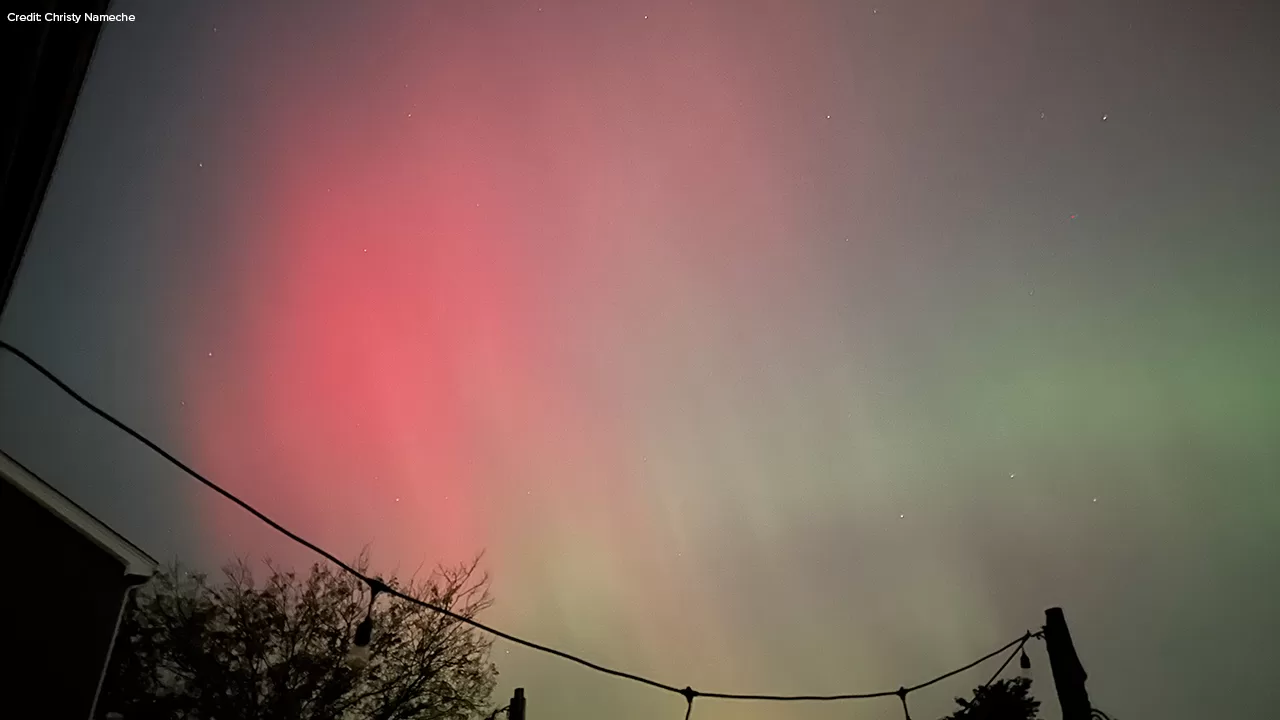The Northern Lights visible in Montgomery, Ill. on Thursday, October 10, 2024.Christy Nameche
The northern lights, or aurora borealis, were visible in the Chicago area on Thursday night, October 10, 2024. This rare spectacle was made possible by a severe solar storm, which also posed a potential threat to power grids and radio communications in parts of the United States. Sky watchers across Illinois were treated to a dazzling display of vibrant colors lighting up the night sky.
Videos and photos began pouring in from residents across the region, including places like Richmond and Montgomery in northern Illinois. People quickly shared their excitement about witnessing such a celestial event. Many viewers pointed their smartphones toward the sky, capturing images of the aurora that were brighter and more visible than what the human eye could perceive.
The phenomenon was triggered by a strong geomagnetic storm, which occurs when solar winds from the sun’s outburst interact with Earth’s magnetic field. This particular solar storm had been detected earlier in the week, prompting the National Oceanic and Atmospheric Administration (NOAA) to issue a severe geomagnetic storm watch for Thursday into Friday. Solar storms of this magnitude can stress power grids and even temporarily disrupt radio signals, adding an element of concern amid the beauty of the northern lights.
The sun is currently nearing the peak of its 11-year solar cycle, which means increased solar activity, such as the outbursts responsible for auroras, is becoming more common. In fact, a solar storm in May of this year also produced dazzling northern lights across the Northern Hemisphere. However, that storm passed without causing any major disruptions. This time, the impact of the storm remains to be seen, though experts warn that power and communication systems may experience temporary issues.
For many Chicagoans, this was a once-in-a-lifetime opportunity to see the aurora borealis without traveling far from home. Typically, these lights are visible much further north, near the Arctic regions. But thanks to the strength of the solar storm, the colorful lights were pushed much further south than usual. Viewers in the Midwest, as well as in Northern California and other parts of the United States, were advised to keep their eyes on the sky for a chance to witness the spectacle.
As the night progressed, some viewers reported that the lights became more vibrant, shifting between shades of green, pink, and even purple. The aurora borealis is created when charged particles from the sun collide with gases in Earth’s atmosphere, causing the gases to emit light. The color of the aurora depends on which gas is being hit – oxygen produces green and red lights, while nitrogen produces blue and purple hues.
While the sight of the northern lights was captivating, it came with a backdrop of other challenges. The United States is currently grappling with major back-to-back hurricanes, and now, with the threat of power grid stress from the solar storm, the pressure on infrastructure is growing. Power companies have been monitoring the situation closely to prepare for any potential disruptions.
In addition to affecting power grids, solar storms can also cause issues with satellite-based technology, including GPS and radio signals. This is because the storm’s electromagnetic energy can interfere with the signals that satellites send back to Earth. Although no major disruptions have been reported as of yet, there is still a possibility that some areas may experience temporary outages.
As of Friday morning, no serious outages had been reported in the Chicago area, but officials are continuing to monitor the situation. The NOAA has warned that the effects of the solar storm may last through Friday, so it’s possible that there could still be some disruptions in the coming hours.
The northern lights were visible well into the night on Thursday, with many people staying up late to catch a glimpse of the rare event. Amateur photographers and professional sky watchers alike were thrilled by the display, with many describing the lights as magical and awe-inspiring.
For those who missed the show, there may still be another chance to see the northern lights tonight, depending on the continued strength of the solar storm. Experts recommend finding a dark spot away from city lights and looking northward to maximize the chances of seeing the aurora.
While the beauty of the northern lights captivated the Chicago area, it also served as a reminder of the power of nature and the far-reaching effects of solar activity. As the sun continues through its active phase, events like this may become more common, giving more people the opportunity to witness the stunning light show.
#NorthernLights #ChicagoSky #AuroraBorealis #SolarStorm #CelestialEvent
